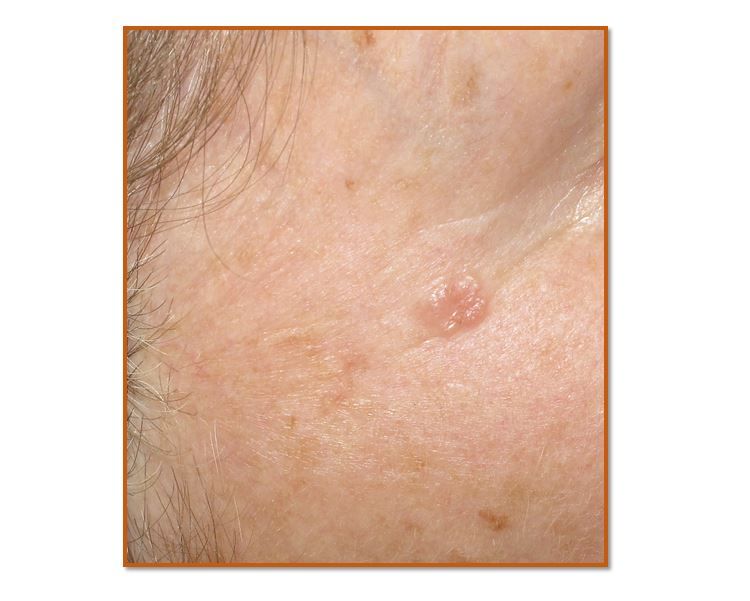- Clinical Technology
- Adult Immunization
- Hepatology
- Pediatric Immunization
- Screening
- Psychiatry
- Allergy
- Women's Health
- Cardiology
- Pediatrics
- Dermatology
- Endocrinology
- Pain Management
- Gastroenterology
- Infectious Disease
- Obesity Medicine
- Rheumatology
- Nephrology
- Neurology
- Pulmonology
Shiny Pink Nodule on Malar Cheek
A 68-year-old woman presents with a new 6-mm nodule with central ulceration and a rolled border on the right cheek. What's your diagnosis? How would you treat?

A 68-year-old female with a history of basal cell carcinoma presents to your office concerned about a new facial lesion she noticed about 6 months ago. You note a 6-mm shiny, skin-colored-to-pink nodule with central ulceration and a rolled border on the right malar cheek, temporal area. She has fair skin color and moderate to severe photo damage.
Based on this presentation, what is the most likely diagnosis?A. Actinic keratosis
B. Seborrheic keratosis
C. Traumatized intradermal nevus
D. Nodular basal cell carcinoma
E. Superficial basal cell carcinoma
F. Hydrocystoma
Please click here for answer and discussion.
Answer: D. Nodular basal cell cacrinoma. The lesion described is a basal cell carcinoma (BCC), a tumor found on sun damaged skin that is relatively easily recognized during routine skin examination. BCC is more common than all other human malignancies combined and its incidence continues to rise, with more than 2.8 million new cases of BCC diagnosed annually in the United States.1
The main clinical subtypes of BCC include nodular BCC accounting for 50-79% of all BCCs, followed by superficial BCC accounting for up to 15% of BCCs, and morpheaform BCC estimated at 5-10% of BCC cases.2
Nodular BCC presents as pink to pearly shiny papules or nodules often with telangiectasia and ulceration.3 Initially the lesions have a smooth surface, but with time they enlarge and ulcerate to form an elevated, rolled border.3
Risk factors for BCC include those of other skin cancers namely sun exposure, fair complexion, light eyes, and increasing age.4 Intermittent, intense UVB exposure is the greatest risk factor, but other risk factors include chronic immunosuppression, radiation therapy, and arsenic exposure.5
Next: Is a biopsy required?
BCC can appear on any part of the body. Mainly it is found in areas with extensive sun exposure, with about 80% located on the head and neck.6 Clinical diagnosis can be quite sensitive and specific for BCC, however a biopsy is required for confirmation and classification of histologic subtype, which predicts behavior and has implications for therapeutic decision making.5
Metastases of BCC are rare, but treatment is indicated due to the destruction of local tissue and locally invasive activity.4
Multiple treatment modalities are available for BCC; which of the following is recommended?
A. Moh’s micrographic surgery (MMS)
B. Cryotherapy
C. Simple excision with 3mm margin
D. Electrodessication and curettage
E. 5-fluorouracil topical therapy
Please click here for answer and discussion.
Answer: A. Moh's micrographic surgery. MMS is a dermatologic surgery technique that optimizes margin control and tissue conservation and is the first line treatment of BCC that is high risk for recurrence or for optimal preservation of function and cosmesis.7 A combination of factors including anatomic location, histologic features, primary or recurrent tumors, and patient characteristics influence the choice of treatment.7
References:
1. Mohan SV, Chang ALS. Advanced Basal Cell Carcinoma: Epidemiology and Therapeutic Innovations. Current Dermatology Reports. 2014;3(1):40-45.
2.Marzuka AG, Book SE. Basal cell carcinoma: pathogenesis, epidemiology, clinical features, diagnosis, histopathology, and management. The Yale journal of biology and medicine. 2015;88(2):167-179.
3.Bolognia J, Jorizzo JL, Schaffer JV. Dermatology. [Philadelphia]: Elsevier Saunders; 2012.
4.Linares MA, Zakaria A, Nizran P. Skin Cancer. Primary care. 2015;42(4):645-659.
5. Gandhi SA, Kampp J. Skin Cancer Epidemiology, Detection, and Management. The Medical clinics of North America. 2015;99(6):1323-1335.
6. Wong CS, Strange RC, Lear JT. Basal cell carcinoma. BMJ (Clinical research ed.). 2003;327(7418):794-798.
7. Lewin JM, Carucci JA. Advances in the management of basal cell carcinoma. F1000prime reports. 2015;7:53.
8. app. AAoDMSA-pUCA. https://www.aad.org/members/aad-apps/mohs-auc.
9.Connolly SM, Baker DR, Coldiron BM, et al. AAD/ACMS/ASDSA/ASMS 2012 appropriate use criteria for Mohs micrographic surgery: a report of the American Academy of Dermatology, American College of Mohs Surgery, American Society for Dermatologic Surgery Association, and the American Society for Mohs Surgery. Journal of the American Academy of Dermatology. 2012;67:531-550.
